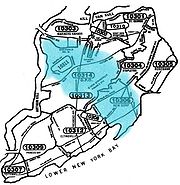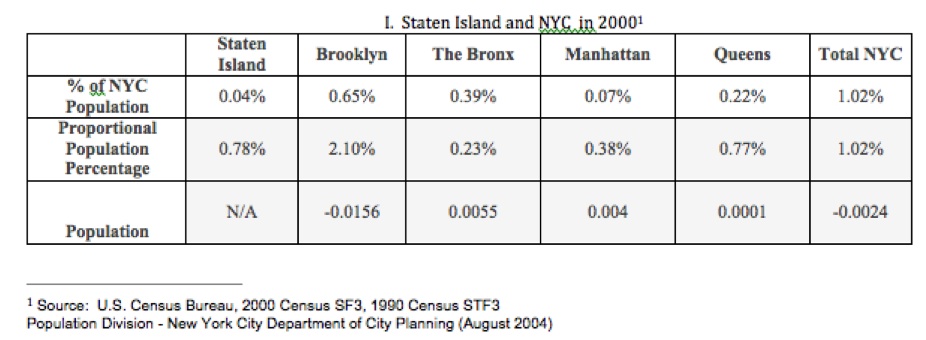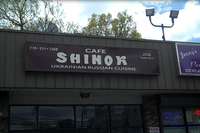From The Peopling of New York City
Contents |
Overview
The Russian community on Staten Island currently consists of 3,452 people and makes up around .77 percent of the entire population on Staten Island. The main centers of settlement are in the 10314 and 10306 zip code areas, bounded by Midland Beach, Newdorp, New Springville, the W. Shore Expressway, and Staten Island Expressway. The current immigration of Russians to Staten Island took off in the early 1990s, following the fall of the Soviet Union. One of the cultural landmarks for the current Russian population on Staten Island is the restaurant Café Shinok on Hylan Boulevard.
Demographics
When studying a certain culture, one needs to first find quantitative data based on demographics in order to understand more about that particular culture. There are various ways of structuring any data that is found and many ways of using it to see a trend and predict future numbers. These two tables were structured in a way that would allow the population of Russian immigrants on Staten Island to be compared to the population of Russian immigrants in New York as a whole and each borough. This table spans the 1990 and 2000 census data as well as incoming Russian immigrants in 2001 and 2002.
Table One shows that the foreign Russian population in relation to all of New York’s population is the smallest in Staten Island compared to other boroughs. However, once the number of Russian immigrants was proportionately placed over the entire population of Staten Island, it became the second borough with the most Russian people. This means that, although Staten Island has the smallest total Russian population, it has the second-most-densely concentrated Russian population in New York City as a whole. Likewise, each borough had its Russian population placed over its entire population to make a more accurate picture of the Russian immigrant population density in relation to each borough’s overall population density.
Table Two, which is derived from the 2000 census report, illustrates some of the difficulties of tracking Russian settlement. When preparing the second table, the numbers for 1980 populations could not be provided Russia was part of the Soviet Union and there was no way to differentiate who was who from the Soviet immigrants based on numbers. The column for 1990 included numbers from the Soviet Union, but those numbers are not only based on Soviet Russians. Thus, instead of accurately showing Russian settlement, Table Two illustrates that the population from 1990 was more of a marker that potentially illustrates how the Russian population grew in general.
Since the breakup of the Soviet Union in 1991 there has been a large influx of Russian immigrants to America and, more specifically, New York City. One could see these trends based on Table Two and the fact that the percentage of the Russian population rose in every subsequent year.
One of the trends which is not clearly reflected in the demographic data available is internal movement of Russian immigrants. As a result, our data for 2001 and 2002, based on the most recent records of the American Community Survey (ACS) on the foreign born Russian population in Staten Island, contains a large percent error. The population numbers and percents were obtained by adding Russian immigrants who came to Staten Island during those years to the population of the previous year. Due to this, the numbers do not show the migration of the population of foreign-born Russian immigrants from other parts of the United States.
History
There has been a steady trickle of Russian immigrants to the United States ever since the 1700s. However, this flow of Russians into the United States began to steadily increase as the years progressed to the early 1800s and early 1900s. Most scholars argue that most Russian immigrants came to the United States in order to escape poverty and religious persecution.
Most Russian immigrants commonly think of America as a safe haven -- a sort of immigrant nation -- where they would find acceptance and better lives. To the 100,000 Russian immigrants that came to live in America, freedom required great sacrifices. When the Russian immigrants emigrated to the United States many spoke Russian and Ukrainian, but had minimal proficiency in English. These immigrants struggled to find jobs, buy homes, and find acceptance from American citizens.
While scholars have written about Russian immigration generally, very little exists about Russian immigrants in Staten Island. This presents a serious challenge to anyone wanting to examine the history of the local Russian community.
The People
Many of the members of the local Russian population on Staten Island came to New York City in the early 1990s. Yuriy Chepelova came to live in New Jersey sometime in March 2010. He is currently employed in New Jersey and waiting for the arrival of his family during the summer of 2010. Larisa Barbashova immigrated to America from a republic that used to be part of the Soviet Union and is now referred to as Uzbekistan where she was a journalist. Her decision to come to America was based on a choice that involved choosing a career or choosing to build a family. She picked the latter and got married to a United States citizen that resided in Brooklyn, NY. She is currently the mom of Igor Barbashov and a College of Staten Island student. Ester Beygel moved to America a little over 14 years ago in order to evade religious persecution. She currently resides with her family in a house on Staten Island.
Ethnic Stages
Many times one can learn about a particular nation’s history through its food—such is the case with Russia. The Russian cuisine stems mostly from the peasant population that lives in rural areas with harsh winter conditions. Thus, as the nation’s food availability changed due to various economic conditions, so did the menu created by the poor, rural villagers. Traditionally, many Russian dishes are served in bowls in a three-course style menu that begins with appetizers consisting of salads and soups that lead into various meat entrees and, finally, desserts. Due to food being a major part of the Russian culture, it is the first thing that Russian immigrants brought to America and, consequently, is one of the few aspects of the culture that is still upheld by Russian Americans including the owners of Cafe Shinok.
Readings
1) Behnke, Alison. Russians in America. Minneapolis: Lerner Publications Co, 2006. Subject heading: (Russia Emigration and immigration History united states) Worldcat
2) Greene, Meg. The Russian Americans. Immigrants in America. San Diego, Calif: Lucent Books, 2002. Subject heading: (Russia Emigration and immigration History united states) Worldcat
3) American Jewish Committee, and Research Institute for New Americans. Russian Jewish Immigrants in New York City: Status, Identity, and Integration. New York, NY: American Jewish Committee, 2000. Subject heading: (Russia Immigrants New York City) Worldcat
4) Bikel, Ofra, Jessica Savitch, and Anita Sangiolo. The Russians Are Here. Boston, Mass: WGBH Educational Foundation, 1983.- documentary (Frontline) Subject heading: (Soviet Union Emigration and immigration Russians) WorldCat
5) Trumbauer, Lisa, and Robert Asher. Russian Immigrants. Immigration to the United States. New York: Facts On File, 2005. Subject heading: (Russian Immigrants united states history) WorldCat
6) Shasha, Dennis, and Marina Shron. Red Blues: Voices from the Last Wave of Russian Immigrants. New York: Holmes & Meier, 2002. Subject heading: (Russia (Federation) Emigration and immigration 20th century) Worldcat
7) Gorjevsky, Jane. Documenting Russian and Eastern European Immigrant Culture in American Manuscript Repositories: Private Philanthropy Archives. Slavic & East European Information Resources 7.2/3 (2006): 9-28. Academic Search Complete. EBSCO. Web. 21 Mar. 2010.
8) Hinds, Lester. Russians are the largest immigrant group in N.Y.C. New York Amsterdam News 85.49 (1994): 8. Academic Search Complete. EBSCO. Web. 21 Mar. 2010.
9) Concha, Delgado-Gaitan. Russian Refugee Families: Accommodating Aspirations through Education. Anthropology & Education Quarterly 25.2 (n.d.): JSTOR SRU gateway. EBSCO. Web. 21 Mar. 2010.
10) Cohen, Yinon.; Haberfeld, Yitchak. Self-Selection and Earnings Assimilation: Immigrants From the Former Soviet Union in Israel and the United States. Demography 44.3 (n.d.): 649-668. Project MUSE. EBSCO. Web. 21 Mar. 2010.
Further Research
Relevant LOC Subject Headings:
• Russian Immigration United States + New York City • Russia Emigration and immigration + New York • Soviet Union Emigration and immigration New York • Russia (Federation) Emigration and immigration united states • Russia (Federation) Emigration and immigration 20th century
Relevant Keywords:
• Soviet Union • New york • Russian • Russia • Immigration • Migration • United states • 20th century • Russians • New York City



